"Indonesia, as a diverse country, provides you a challenge to meet people from different backgrounds and cultures with unique characteristics. The capital of the country, Jakarta, serves as a melting pot of those diversities. In this city, you can witness the blend between western and eastern cultures through food, people, life style, infrastructures and facilities."
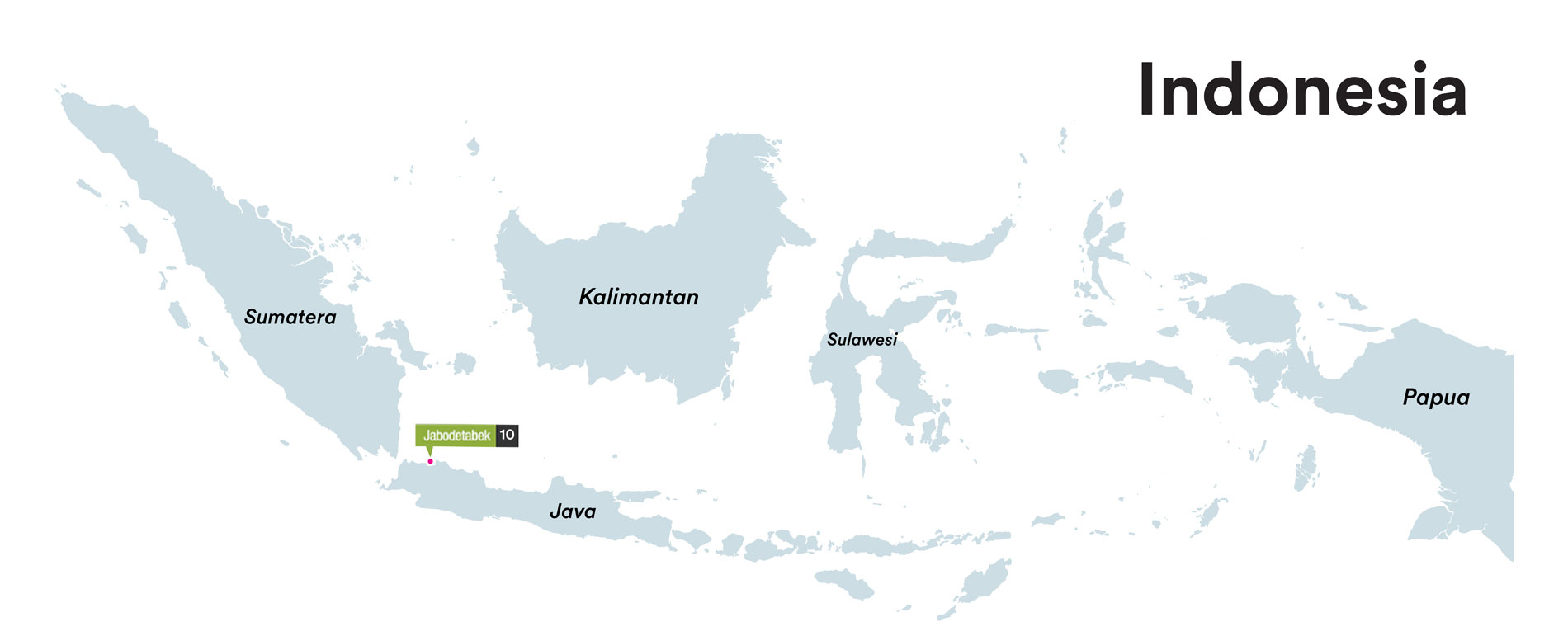
The distance between Aceh and Papua is more than 4 000 kilometres (2500 miles), comparable to the distance between France and Iran or between New York and San Fransisco. it takes more than 8 hours on a Boeing 747 jet flight to cross from the west to the east passing 3 different time zones.There are more than 400 volcanoes in Indonesia. Only 130 volcanoes are considered active volcanoes. There are many undersea volcanoes in Indonesia. Papua is the second largest island in the world.
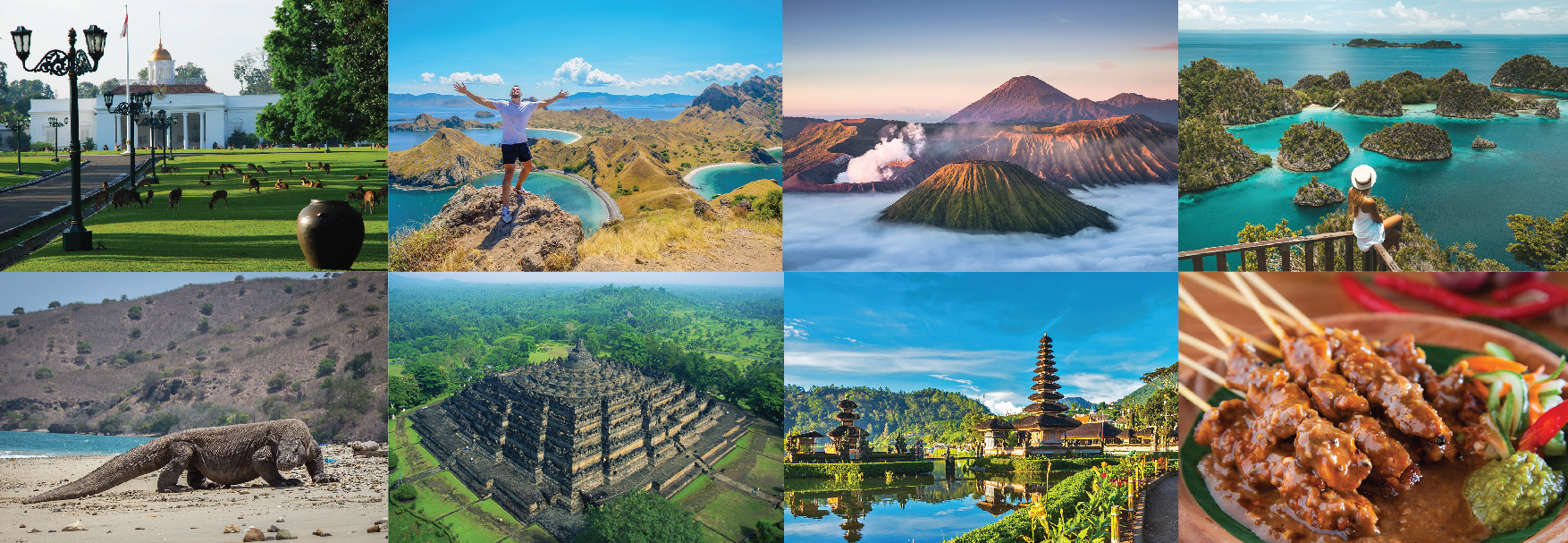
Provinces are usually grouped under main big islands and their surroundings, as listed below:
-
Sumatra (and the Riau Islands, Bangka and Belitung) Wild and rugged, the 6th largest island in the world has a great natural wealth.
-
Kalimantan (Borneo) Uncharted jungles, mighty rivers, home of the orangutan, a paradise for the adventurer.
-
Java (and Madura) The country's heartland, big cities including the capital Jakarta, and a lot of people packed on a not-so-big island. Also features the cultural treasures of Yogyakarta, Borobudur and Prambanan.
-
Sulawesi (Celebes) Strangely shaped, this island houses a diversity of societies and some spectacular scenery.
-
Nusa Tenggara (Bali, Lombok, Sumbawa, Flores, Komodo and West Timor) Also known as the Lesser Sunda Islands, the "Southeast Islands" contain scores of ethnic groups, languages and religions.
-
Maluku (Moluccas) The historic Spice Islands, largely unexplored and almost unknown to the outside world.
-
Irian Jaya (Papua) The western half of the island of New Guinea, with mountains, forests, swamps, an almost impenetrable wilderness in one of the remotest places on earth.
Indonesia has a population of 255 million making it the world's 4th largest most populated country out of 235 after China, India and the US. The population is made up of over 200 ethnic groups, many of which have there own cultures and languages.
It is the world's largest tropical paradise with an average temperature of 21 - 34 Celsius (70 - 93 Fahrenheit).
Food Glorious Food
For those who would like to experience the variety of food that Indonesia can offer.
The food here in Indonesia is of tremendous variety. Simple dishes with complex flavours made by carefully mixing herbs and spices and other ingredients to combine into what can only be described as a taste sensation, and not just 5 Star restaurants.
You get this same attention to detail even from the street vendors and roadside waroengs. The biggest complaint levelled against Indonesian food is "everything is fried" and whilst this is just not true,..........here’s an introduction;
From top to bottom of these pictures we have:
-
Nasi Goreng (Fried Rice)
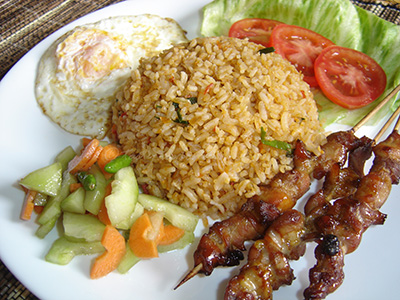 This is a staple part of the Indonesian diet and possibly the most versatile meal on the list. This meal can be eaten for breakfast, lunch or dinner or just as a snack. This dish can be prepared in a matter of seconds as long as the ingredients are ready to go. Here's the recipe and method from a local lunchtime waroeng. Basically you add some oil, garlic and salt to a hot wok and lightly stir in an egg. Next is added a little chicken stock and some thick soy sauce called kecap (pronounced ketchup but not to be confused with the tomato sauce variety) and to this is added a portion of steamed rice. This is stir fried and has pieces of cooked chicken and, depending on your taste, chopped birds eye chillies*are added. Now it's just about combining the ingredients. If this is served as a take-away then it is scooped onto a piece of banana leaf and topped with fried shallots, chopped pickled vegetables and shredded cabbage. Finally garnished with prawn crackers called krupuk, the cost of this lunch can be as little as RP12,000. The picture shows the more traditional "eat-in" service of the dish straight out of a bowl mould and topped with a fried egg and garnished with cucumber and tomato but, in my opinion, the dish described is the best. * The chillies are usually optional although in some dishes are already present. Indonesian preference is usually towards spicy. If you require your meal "spicy free" then the expression tidak pedas should immediately be in your vocabulary. Asking for something pedas usually ends up in vindaloo++ proportions of spicy heat! It should be born in mind that very little food here is ever entirely without being a little spicy.
This is a staple part of the Indonesian diet and possibly the most versatile meal on the list. This meal can be eaten for breakfast, lunch or dinner or just as a snack. This dish can be prepared in a matter of seconds as long as the ingredients are ready to go. Here's the recipe and method from a local lunchtime waroeng. Basically you add some oil, garlic and salt to a hot wok and lightly stir in an egg. Next is added a little chicken stock and some thick soy sauce called kecap (pronounced ketchup but not to be confused with the tomato sauce variety) and to this is added a portion of steamed rice. This is stir fried and has pieces of cooked chicken and, depending on your taste, chopped birds eye chillies*are added. Now it's just about combining the ingredients. If this is served as a take-away then it is scooped onto a piece of banana leaf and topped with fried shallots, chopped pickled vegetables and shredded cabbage. Finally garnished with prawn crackers called krupuk, the cost of this lunch can be as little as RP12,000. The picture shows the more traditional "eat-in" service of the dish straight out of a bowl mould and topped with a fried egg and garnished with cucumber and tomato but, in my opinion, the dish described is the best. * The chillies are usually optional although in some dishes are already present. Indonesian preference is usually towards spicy. If you require your meal "spicy free" then the expression tidak pedas should immediately be in your vocabulary. Asking for something pedas usually ends up in vindaloo++ proportions of spicy heat! It should be born in mind that very little food here is ever entirely without being a little spicy. -
Mie Goreng (Fried Noodles)
 It's difficult to tell just which is more popular here, Rice or Noodles. We’d have to say that on reflection it would be noodles. Indonesians eat noodles in so many ways from the amazing variety of pot noodles and dried noodles (Indomie) found in supermarkets that with a little hot water, reconstitute themselves into great snacks (or in the case of cash strapped teachers, possibly a staple diet) to angel hair noodles or udon noodles.
It's difficult to tell just which is more popular here, Rice or Noodles. We’d have to say that on reflection it would be noodles. Indonesians eat noodles in so many ways from the amazing variety of pot noodles and dried noodles (Indomie) found in supermarkets that with a little hot water, reconstitute themselves into great snacks (or in the case of cash strapped teachers, possibly a staple diet) to angel hair noodles or udon noodles.
This picture shows the most traditional way to eat them. Stir-fried with some vegetables and some stock and of course, the prerequisite chillies! -
Gado-Gado (Vegetable Salad)
 Possibly the least appetizing dish from the pictures but don't let that fool you. Gado-Gado can be translated into English as "jumble" and basically that's what this is. A jumble of steamed vegetables coated in peanut sauce (and chillies) and usually served with plain steamed rice or Lontong, a compacted rice cake.
Possibly the least appetizing dish from the pictures but don't let that fool you. Gado-Gado can be translated into English as "jumble" and basically that's what this is. A jumble of steamed vegetables coated in peanut sauce (and chillies) and usually served with plain steamed rice or Lontong, a compacted rice cake. -
Soto Betawi Ayam (Chicken Soup)
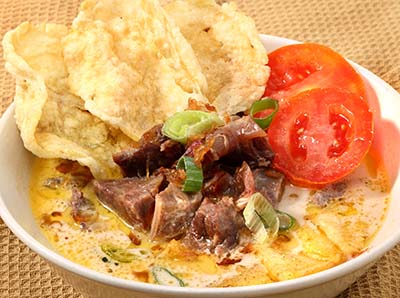 The fourth picture down is a great soup made with coconut milk, chicken and vegetables. It also has these weird egg crackers which don't taste particularly nice on their own, but once soaked in the soup give it another texture altogether.
The fourth picture down is a great soup made with coconut milk, chicken and vegetables. It also has these weird egg crackers which don't taste particularly nice on their own, but once soaked in the soup give it another texture altogether. -
Sate Kambing (Barbecued Goat Skewers)
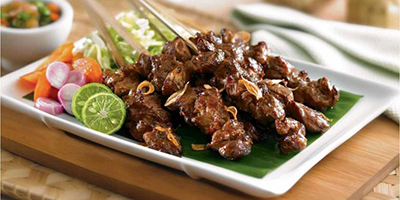 There are many types of sate, quite possibly the more popular one is chicken, but this goat sate is more complex. The chicken version is barbecued then coated in a spicy peanut sauce and served on rice. The goat version is barbecued but then served with a sauce of sweet soy, chopped chillies, shredded cabbage, tomato, sliced shallots and lime juice.
There are many types of sate, quite possibly the more popular one is chicken, but this goat sate is more complex. The chicken version is barbecued then coated in a spicy peanut sauce and served on rice. The goat version is barbecued but then served with a sauce of sweet soy, chopped chillies, shredded cabbage, tomato, sliced shallots and lime juice. -
Iga Bakar (Grilled Beef Ribs)
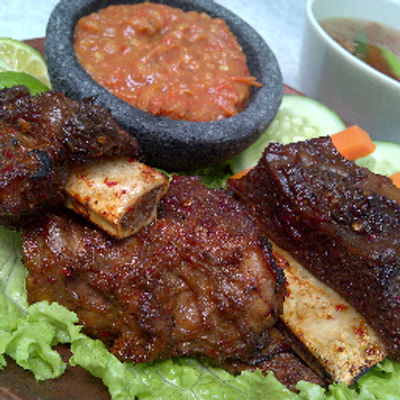 Pork isn't entirely off the menu in Indonesia but with the majority of the population being Muslim there are only select places that you find it. This dish does away with the need for pork ribs. The ribs you get in the waroengs and restaurants are usually huge and often served with something called Sambal*. Don't order if you don't like fat. whilst there is a lot of meat on the ribs, there is also some fat too
Pork isn't entirely off the menu in Indonesia but with the majority of the population being Muslim there are only select places that you find it. This dish does away with the need for pork ribs. The ribs you get in the waroengs and restaurants are usually huge and often served with something called Sambal*. Don't order if you don't like fat. whilst there is a lot of meat on the ribs, there is also some fat too
Sambal - Initially there are two types of sambal, matang (cooked) or mentah (raw). but the varieties don't stop there......- Sambalterasi
Possibly the most common style of sambal with a strong flavour coming from red and green chillies, shrimp paste, sugar, salt, and lime juice - Sambalasam
This is similar to sambalterasi but with the addition of a tamarind concentrate. - Sambalkacang
A mixture of chillies with garlic, shallots, sugar, salt, crushed fried peanuts and water. - Sambalbajak
Chilies fried with oil, garlic, candlenuts, this is a darker and richer sambal. - Sambalpencit
Take some sambalterasi and add shredded young mango. Pencit means young mango in Indonesian - Samballadoijo
This is a Padang speciality- the sambal is green, not red and is made from green tomatoes, green chilies, shallots and spices and then stir fried.
The list goes on and is seemingly endless! - Sambalterasi
-
Bebek Goreng (Fried Duck)
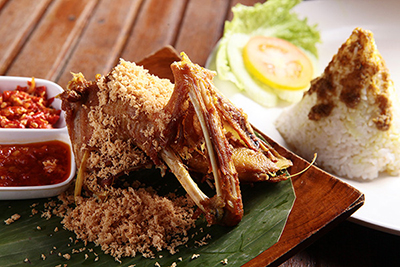 There are many Chinese restaurants here that serve great duck but this dish, found in waroengs and roadside restaurants is simple. Fried portions of duck served with a salad of raw cabbage leaves, mint leaves, tomato cucumber and a hot and spicy green chillisambal.
There are many Chinese restaurants here that serve great duck but this dish, found in waroengs and roadside restaurants is simple. Fried portions of duck served with a salad of raw cabbage leaves, mint leaves, tomato cucumber and a hot and spicy green chillisambal.
You could visit tripadvisor.com to see the variety of food in Jakarta and Indonesia.

.png)
 (1).png)


